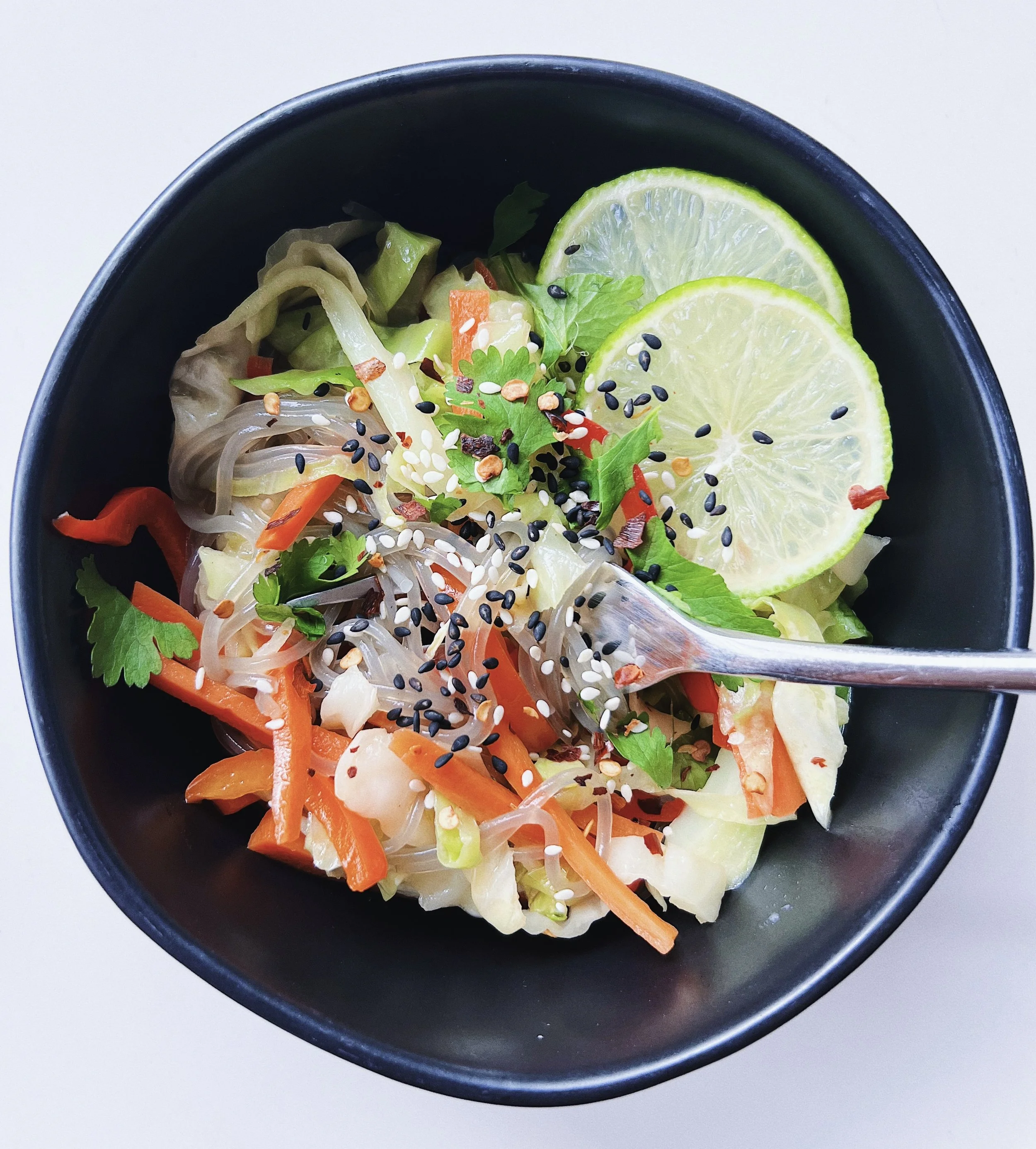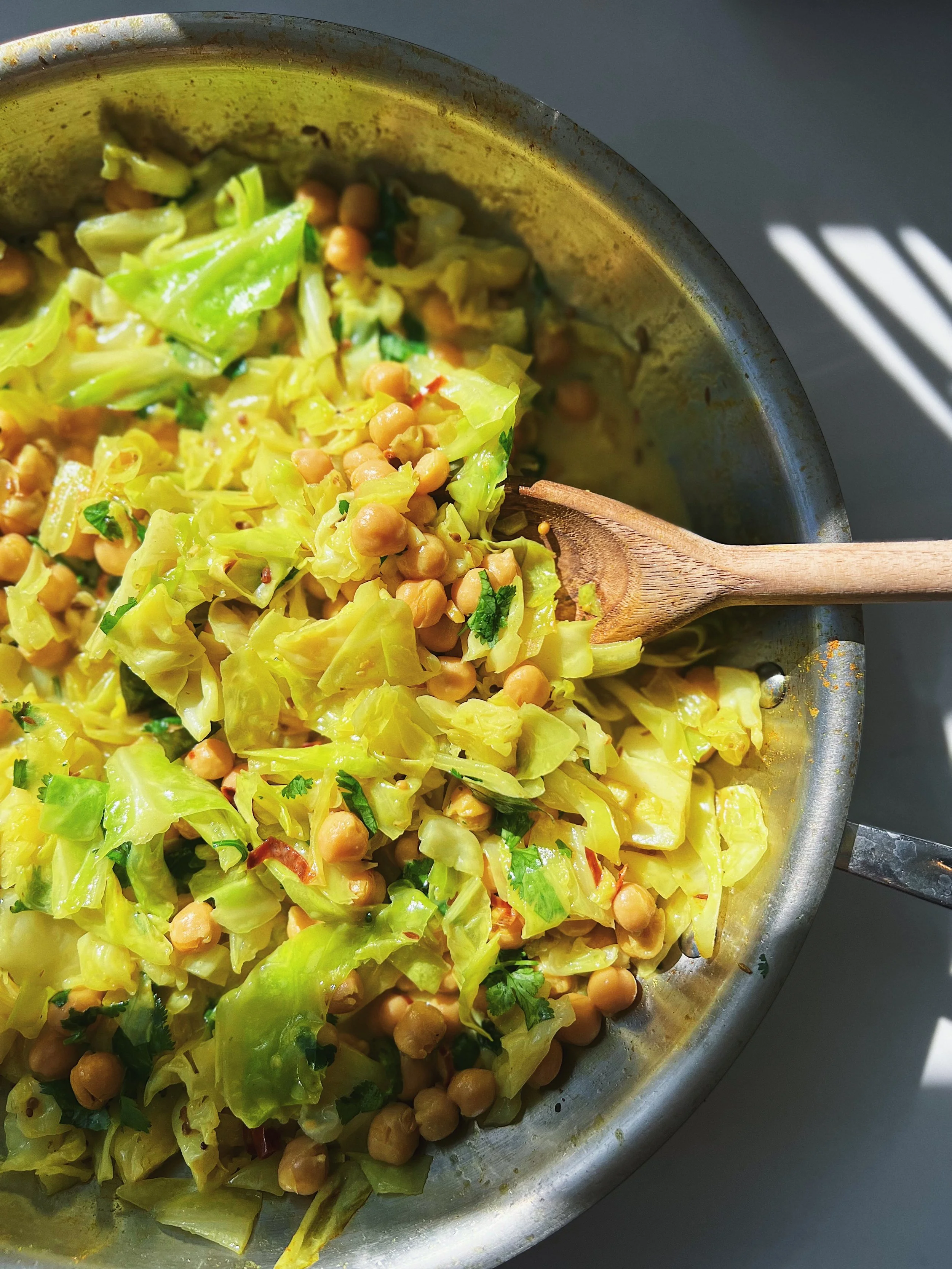Japchae warm winter salad
I love a warm salad situation.
I’ve got nothing against cool and crunchy ones (I love those too), but whenever possible, I try to enjoy warmer salads since they’re far easier to digest and cause way less bloat and discomfort than cold ones.
My latest creation includes Korean glass noodles, known as japchae, which is made from sweet potato starch, a variety of beautiful winter vegetables, and soy ginger and carrot vinaigrette.
Keep scrolling to learn more, including why it’s so damn good for you and ideas on how to recreate it at home and even make adjustments based on your liking or dietary needs. Or just scroll to the bottom to check out the full recipe.
Health Perks
Vegetable-loaded. The veggies do a lot of the heavy lifting in this dish, which means its a fiber-filled meal that contains a wide variety of vitamins, minerals, antioxidants and other nutrients to support your overall health and help prevent chronic diseases.
Contains zero aggravating ingredients. It’s dairy, gluten, grain, sugar and oil-free. As gentle as it gets when it comes to digestion and should not aggravate the body whatsoever. That includes the dressing as well!
Filled with fiber. You’re getting a wide variety of vegetables in this dish, all of which are filled with fiber to help you feel full for longer, which can help prevent overeating throughout the day along with promoting regular elimination.
Low in calories. The dish is relatively low in calories, making it a great option for those trying to lose or maintain a healthy weight.
Energy boosting. The carbohydrates in sweet potato noodles provide a quick source of energy, making it a great option for a midday meal.
Warm salads are easier to digest. Warm food is easier to digest than cold. The body has to work harder to raise the temperature of cold food to body temperature, which is needed for proper digestion. Warm food, on the other hand, is closer to body temperature so digestion occurs more effectively, efficiently and therefore faster. Warm food also stimulates digestive juices and increases the secretion of digestive enzymes, which also aids the digestive process. So if optimal digestion is a goal or concern, but you also love a salad situation, try warming it and enjoy the best of both worlds!
Other Thoughts, Tips and Suggestions
Cook separately. Boil the noodles and pan fry the vegetables separately. These noodles are sensitive to overcooking and can easily become sticky or gummy if placed on heat for too long.
Thinly slice your vegetables. This will let you cook them quickly and on a lower heat, which will help you retain those nutrients.
Rinse the cooked noodles. Don’t skip this step. After cooking the noodles in water, drain the water and then rinse the noodles in cold water to prevent them for getting sticky or gummy.
Adding protein. For a lean protein, add cooked tofu. Or if you wish to follow food combining principals for optimal digestion, you can try adding chickpeas as they pair well with starchy noodles (i.e. they digest at the same time, which means no sitting and fermenting in your stomach that leads to bloat, gas, discomfort, etc.).
Carbohydrate-free option. Sub kelp noodles for japchae if you want to reduce your starch intake, or wish to add a protein like tofu and wish to follow food combining principles for optimal digestion.
If you’re going to add oil, make it sesame. I’ve designed this dish to be oil-free, but sesame oil adds a delicious rich and nutty flavor that pairs incredibly with japchae. All you need is a minimal amount - just a small drizzle over your bowl right before you go to eat it.
Flavor boosters. Here are some small ways to add MAJOR flavor to this dish - fresh cilantro, a squeeze of lime juice, a drizzle of sesame oil, a sprinkle of gomasio, furikake or plain sesame seeds.
Go ahead and use whatever veg you have on hand (or enjoy most). These noodles are delicious, but it’s the veg that adds the most the nutritional value to this dish so don’t skimp out.
Tools I Used (And Love)
Ensure you have everything you need to prepare your dishes before you set out to make them. And if you don’t, these are the exact tools I used and loved that I know you will too!
Check out the full recipe below. Hope you love it as much as I do!
Warm Winter Japchae Salad
Prep Time: 10 minutes | Cook Time: 10 minutes Yields: 2-4 servings
Ingredients:
(For the salad)
1/4 pckg of japchae (I use this brand)
1/2 head of green cabbage, thinly sliced
1 red bell pepper, thinly sliced and seeds discarded
1 large carrot, cut into match sticks
1 green onion, sliced (green and white parts)
small handful fresh cilantro, destemmed
1/2 lime, juiced
1/2 tsp red chili pepper flakes (optional)
1/2 tsp sesame seeds (optional)
(For the dressing)
1/4 cup rice vinegar
1/4 cup tamari (I prefer the reduced sodium version)
1/4 cup water
1 tbsp sweet white miso
1 inch knob of ginger
1/2 large carrot stick
1 clove of garlic
Directions
Cook your noodles. Place a medium saucepan with water on medium to high heat. Bring to a boil, add your japchae and cook for 5-7 minutes (until noodles are soft). Use a fine mesh strainer to drain the water, then run noodles under cold water for a minute. Use kitchen scissors to cut noodles if you prefer them shorter. Set aside.
Quick cook your veg. Place a medium frying pan on a low to medium heat. Once hot, add a tbsp of vegetable broth (or oil if you prefer) and then add your vegetables. Cook for about 5 minutes until the cabbage starts to “sweat” and your vegetables are warm. Remove from heat, and add cook vegetables to a mixing bowl.
Prep your dressing. Combine all ingredients in a high speed blender. Start to blend on a low to medium speed and slowly increase to the highest speed until ingredients are mixed well and the dressing has a smooth, water-like consistency.
Optional - if you want a completely smooth dressing, pour the contents of the blender through a cheese cloth and into a mason jar.
Combine noodles and vegetables. Add a small amount of japchae noodles to your vegetable bowl and gently mix. Once it is well combined, add more japchae noodles and mix again. Do this until all the noodles have been added to the bowl.
Dress your salad. Slowly pour dressing over the salad. It is a thin and watery dressing, so don’t add the entire batch. It’s very flavorful and a little will go a long well. Mix until ingredients are evenly coated.
Garnish. Top with lime juice, cilantro, optional sesame seeds, chili pepper flakes and small drizzle of sesame oil and enjoy!
Store and reheat. The salad can be stored in the fridge for a few days. To re-heat, add to a frying pan for a quick cook. The noodles will be stuck together, so small drizzle of oil and some heat will help you pull them apart.
If you liked this recipe, be sure to sign up for Eat With: A Newsletter to receive this type of content and other health and wellness tidbits delivered to your inbox every week!














